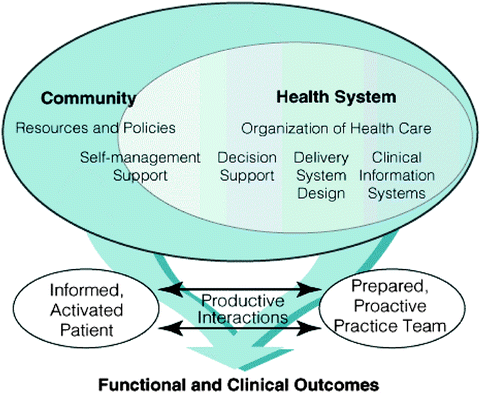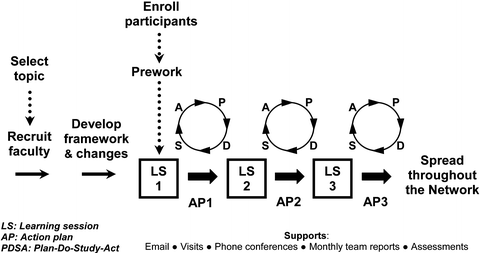Fig. 50.1
Variation in care. a Improving quality by decreasing variation. b Improving quality by shifting distribution
Variation in care has been demonstrated in pediatric IBD [11, 12]. In one study, pediatric gastroenterologists enrolled patients with Crohn disease who were starting treatment with a thiopurine (6-mercaptopurine or azathioprine) or infliximab. Data from 250 patients at 80 sites were examined for variation in diagnostic and therapeutic interventions. Diagnostic studies in which care was uniform included complete blood count, performed in 100% of patients, erythrocyte sedimentation rate and colonoscopy in 96%, and upper endoscopy in 89%. However, imaging of the small bowel had not been performed in 19%, and a stool test for pathogens had not been performed in 29%. Thiopurine methyltransferase (TPMT) had been measured in 61% of patients before treatment with a thiopurine; in 85%, TPMT was normal. Nonetheless, even when TPMT was normal, 40% of patients received an initial dose of thiopurine that was lower than recommended. Testing for tuberculosis before initiating treatment with infliximab was not performed in 30%. In addition, 36% of severely underweight patients were not receiving a multivitamin supplement, supplemental formula, or tube feeding. Another study demonstrated widespread intercenter variation in the treatment of newly diagnosed children with Crohn disease, even after adjusting for possible differences in case mix between institutions. Variation in the use of immunomodulators and infliximab in adults with Crohn disease has also been reported [13]. Thus, there is clear documentation of considerable variation in diagnostic and therapeutic care in pediatric IBD, suggesting the presence of underuse, overuse and potentially misuse of interventions that may lead to unintended differences in health care costs and outcomes.
Documentation of variation in care has been important in efforts to standardize and improve care in other fields of medicine [14]. For example, the Epidemiologic Study of Cystic Fibrosis demonstrated large variations in practice patterns regarding the prescription of various therapies as well as the fact that a significant proportion of cystic fibrosis (CF) patients are not monitored as recommended by the Cystic Fibrosis Foundation (CFF) [15, 16]. In this study, only 58% of patients had quarterly visits to their CF Care Center, 76% had biannual spirometry, 79% had annual airway cultures and 68% had annual chest radiographs [17]. CF Registry reports are now presented in such a way as to reveal practice variation among practice sites, partly in order to motivate an evaluation of this variation and to promote standardization where indicated.
The Chronic Illness Care Model
The Chronic Illness Care Model provides a useful framework for developing changes to the system of IBD care [18], [19]. Wagner and colleagues conducted an exhaustive literature review and program assessment to identify the key components of systems of health care delivery that result in improved outcomes for patients with chronic illness. Wagner’s model includes the following components: family and patient self-management support, decision support, delivery system design, clinical information systems, community resources and the health care organization (Fig. 50.2). Family and patient self-management support includes the methods used by the clinic to increase families’ participation in care. Decision support includes the use of care protocols that are integrated into practice systems. The delivery system design component includes the use of planned encounters, clarity in the roles and responsibilities of team members with appropriate training, and the use of regular meetings of the care team to review performance. The clinical information system refers to the ability of caregivers to access data and use registries for care and to provide regular feedback to the team, and also information technology to facilitate scheduling and patient tracking. A prepared proactive practice team interacts with an informed activated patient to improve functional and clinical outcomes.


Fig. 50.2
The Chronic Illness Care Model. Adapted from EH Wagner, Joint Commission Journal on Quality Improvement 2001;27:65, by permission
The application of improvement science has lead to major advances in quality in the automobile, microchip and other industries [20–22]. Does quality improvement work in health care? Quality improvement interventions utilizing the Chronic Care Illness Model in asthma, congestive heart failure, depression and diabetes have improved clinical outcomes, processes of care and quality of life [23]. Studies of controlled trials of interventions that contain at least one element of the Chronic Care Model have demonstrated significant improvements in care [24]. In a cohort study to determine the effect of a specialist nurse on the outcome of 340 patients with IBD, intervention resulted in a 38% reduction in hospital visits, a 19% reduction in hospital length of stay, a 10% increase in patients in remission and improvement in patient satisfaction [25]. A multi-center randomized controlled trial of a quality improvement project in IBD showed similar results [26].
The Need for Quality Improvement in IBD
Has disease outcome in Crohn disease improved during the last four decades? In a report published in 2004, a structured systematic literature review was performed to evaluate measurable outcomes in Crohn disease. Evaluation of mortality, cancer, disease recurrence, extra-intestinal manifestations, and medication use failed to show hard evidence for improvement in disease outcome in Crohn disease during the last four decades [27]. Despite advances in research and therapy, the application of knowledge to the improvement of health outcomes and quality of life has lagged. Hospitalization rates for IBD, particularly Crohn disease, increased from 1998 to 2004, incurring a substantial rise in inflation-adjusted economic burden [28]. Further, even in the era of biologics, the proportion of patients with IBD not entering remission remains high [29].
Are patients with IBD receiving optimal care? A study found that adults with IBD referred for a second opinion often were not receiving optimal medical therapy [30]. There was suboptimal dosing of mesalamine and immunomodulatory medications, prolonged use of corticosteroids, failure to use steroid-sparing agents, inadequate measures to prevent metabolic bone disease and inadequate screening for colorectal cancer. Many pediatric patients diagnosed with Crohn disease had not been tested for intestinal pathogens, had not had imaging of the small intestine, were not receiving a multi-vitamin supplement, had not been tested for TPMT prior to treatment with a thiopurine, had not been tested for tuberculosis prior to treatment with infliximab, and were receiving suboptimal dosage of medications [11].
Quality improvement in adult gastroenterology has previously focused on endoscopic procedures [31–38]. However, the American Gastroenterological Association Task Force on Quality in Practice issued a report recommending the formation of an AGA Quality Center to assure uniform documentable excellence in quality of clinical care and GI practice, to support the aims for quality health care set forth by the Institute of Medicine, to identify key quality of care indicators in the treatment of digestive diseases and how they will be measured, to develop programs and tools to assist in implementing evidence-based guidelines and measuring and reporting adherence to quality indicators, and to develop patient education materials to ensure that patients have appropriate expectations regarding high-quality, patient-centered, evidence-based care [39]. In 2011 the AGA developed a set of IBD process measures, approved by the American Medical Association’s Physician Consortium for Performance Improvement, that focus on transitioning patients to corticosteroid-sparing therapy and preventive care. The North American Society for Pediatric Gastroenterology, Hepatology and Nutrition has also developed a set of process measures. In conjunction with measure development, the AGA has also developed the Digestive Health Outcome Registry to help practices develop benchmarking, outcomes measurement and population management capabilities for patients with IBD.
The Improvement Model
The Improvement Model is the foundation of a system for innovation and a framework for developing, testing and implementing incremental change [40]. The model is based on three questions (Fig. 50.3): What are we trying to accomplish? How will we know that a change is an improvement? What change can we make that will result in improvement? Any approach to improvement must be based on building and applying knowledge. Within the overall framework, the Plan-Do-Study-Act (PDSA) cycle is a structured application of the scientific method that provides a means to learn rapidly in complex organizational settings. The Plan phase consists of stating the objective of the test, making predictions, and developing a plan to carry out the test. The Do phase consists of carrying out the test, documenting problems and unexpected observations, and beginning an analysis of the data. The Study phase consists of completing the analysis of the data, comparing the test data to predictions and summarizing what was learned. The Act phase consists of deciding upon and carrying out the changes to be made, and considering what will be the objective of the next cycle. The Improvement Model means applying the principles of using data; developing, testing and implementing changes; and working collaboratively to bring about improvement in the outcomes of health care (Fig. 50.4).



Fig. 50.3
The Improvement Model. Adapted from Langley, Nolan, Nolan, Norman and Provost [40], page 10, by permission of Jossey Bass

Fig. 50.4
Repeated use of the Plan-Do-Study-Act cycle. Adapted from Langley, Nolan, Nolan, Norman and Provost [40], page 9, by permission of Jossey Bass
The Improvement Collaborative
An improvement collaborative in IBD is a sequential process in which a group of multi-disciplinary teams from ten or more different practice sites work intensively together using the principals of improvement science to improve the delivery of care and the quality of life of patients with IBD. Improvements consist of redesigning delivery systems to ensure that patients receive recommended care, and are not subject to underuse, overuse, or misuse. An improvement collaborative includes three main phases: (1) a design and development phase, in which the aim and measures for the project are developed (see Table 50.1), and changes to be tested are identified and summarized using formal methods for the design of new processes and systems; (2) an implementation phase in which practice sites work together to test and adapt changes in care delivery; and (3) a dissemination phase, where, as changes in the process of care delivery are tested and reliably achieve desired goals, they are disseminated to other and eventually all pediatric gastroenterology practice sites. Participating sites gather data about their patients’ care, share data about the outcomes of care with all of the other sites, identify sites that are performing better, examine reasons for the better performance, set benchmarks for outcomes, and share ideas to enable the other sites to improve their outcomes. Participating sites gather together for learning sessions to share data and ideas, and then return to their sites to perform PDSA improvement projects there, gathering and sharing new data in an incremental process (Fig. 50.5).

Table 50.1
Measurable outcomes of treatment of pediatric inflammatory bowel disease
Disease activity |
Remission rate |
Interval between relapses |
Complication rates (e.g., fistula) |
Nutritional status |
Growth, final adult height |
Days missed from school |
Emergency department visits |
Hospitalization rate |
Hospital length of stay |
Surgery |
Patient and family satisfaction |
Patient quality of life |

Fig. 50.5
A schematic drawing of the sequence of events in an Improvement Collaborative. Adapted from a presentation of the Institute for Healthcare Improvement
An Improvement Collaborative is intended to encourage practices to adopt a more organized approach to IBD care. It is based on models of behavior change and diffusion of innovations in medical practice including involvement of opinion leaders in the medical community, recognition of a performance gap, involving physicians and staff in developing a strategy to make changes to close the gap, compatibility of the intervention with current practice, and reinforcement of positive change [41]. It is designed to identify and address barriers in the way care is delivered in IBD clinics.
This type of systems intervention is especially important in pediatric IBD clinics because many pediatric IBD practice sites operate within large tertiary medical centers with relatively rigid infrastructures requiring significant and determined effort to change; IBD care is characterized by a complex mixture of preventive and chronic therapeutic interventions; distance and other factors make frequent return visits difficult for many patients, so accidental omission of services and other missed opportunities for care are harder to correct; and the responsibility for care is shared by multidisciplinary teams and multiple physicians with diverse responsibilities who may overestimate the consistency with which they deliver specific services.
The ImproveCareNow Network
The first (and thus far only) improvement collaborative in IBD, called ImproveCareNow, was begun in early 2007; its global aim is to build a sustainable network of all pediatric gastroenterologists in the United States to improve the care and outcomes of children with Crohn disease and ulcerative colitis [42]. In its first 5 years it grew from 8 to 34 centers, with approximately 300 pediatric gastroenterologists and 10,000 pediatric IBD patients. The six primary drivers of the ImproveCareNow Network are a prepared proactive practice team; accurate diagnosis and disease classification; appropriate drug selection and dosage; adequate nutritional intake; adequate growth monitoring; and informed, activated and engaged patients and families.
Stay updated, free articles. Join our Telegram channel

Full access? Get Clinical Tree


